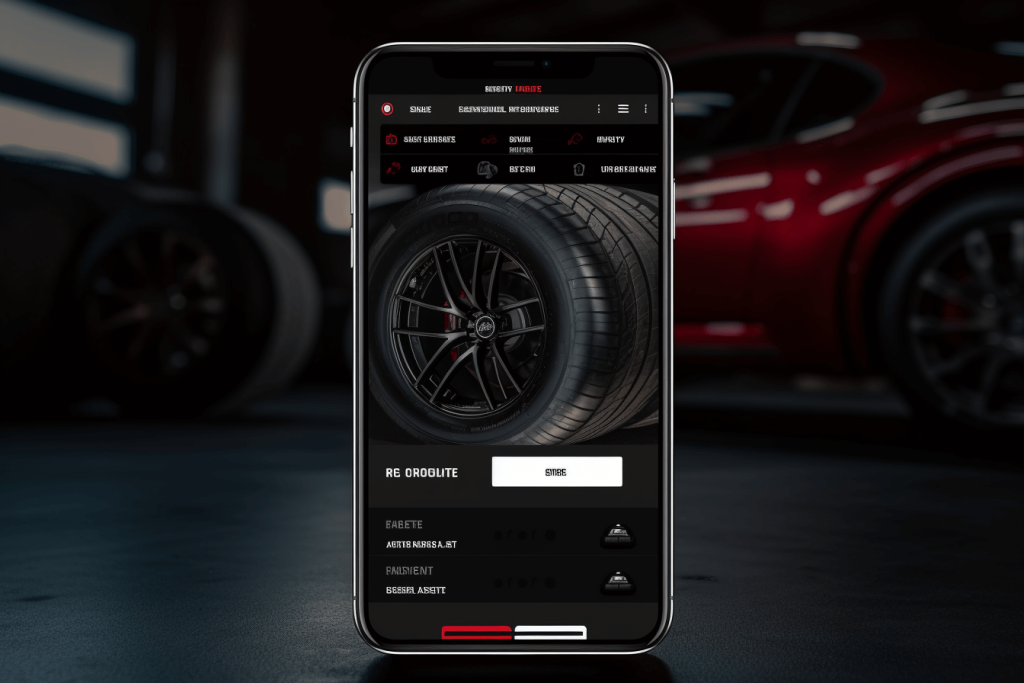As a tire dealer in today’s fast-paced digital world, I know how crucial it is to have an online presence that caters to the ever-growing number of mobile users. With more and more people relying on their smartphones for everything from browsing products to booking appointments, having a mobile-optimized website can make all the difference in attracting new customers and keeping existing ones coming back.
In this article, we’ll explore some key strategies for optimizing your tire dealership’s website for mobile devices, ensuring that you stay ahead of the competition and provide a seamless user experience.
Suppose you’ve been neglecting your website’s mobile performance. In that case, it’s time to get serious about embracing responsive design, enhancing user experience, prioritizing speed and performance, streamlining navigation and layout, and integrating social media and mobile marketing. By implementing these strategies, you’ll improve your customer’s online journey and strengthen their sense of belonging with your brand – something every business should strive for in today’s competitive market.
So let’s dive into these essential tactics and transform your tire dealership into a thriving hub for desktop and mobile users!
Embracing Responsive Web Design

It’s time to fully embrace responsive web design, making your online presence visually appealing and easily accessible for all users!
As a tire dealer, you know how important it is for customers to find the products and services they need quickly. Ensuring that your website is optimized for mobile devices through a responsive overhaul or adaptive redesign will improve user experience and increase the likelihood of attracting new customers and retaining existing ones.
A responsive overhaul involves designing your website so its layout adjusts seamlessly according to the screen size and device visitors use. This ensures that content is easily read, images are appropriately sized, and navigation menus are easily accessible with touchscreens.
On the other hand, an adaptive redesign focuses on creating multiple versions of your site tailored specifically for different devices. Both approaches have their merits – what matters most is finding the best solution for your business.
By investing in mobile optimization for your tire dealership’s website, you’re acknowledging the ever-growing number of consumers who rely on their smartphones and tablets to access information online. Catering to these users demonstrates that you understand their needs and care about providing them with a seamless experience – which can ultimately lead to greater customer satisfaction and loyalty.
So don’t wait any longer! Take action now to ensure that your website offers a top-notch browsing experience regardless of the device used by potential customers.
Enhancing User Experience for Mobile Users
Your customers are on the go, and ensuring their seamless browsing experience on your site can drive sales and satisfaction.
Mobile accessibility is crucial for any tire dealer website to maintain user retention – after all, who wants to waste time navigating a poorly designed site?
By enhancing the user experience for mobile users, you’ll attract new customers and keep them coming back.
To create a flawless mobile browsing experience for your visitors, consider implementing these key elements:
- Responsive design: As mentioned in our previous article, responsive web design ensures your website adapts seamlessly across different screen sizes and devices.
- Fast loading times: Optimize images, minify code, and leverage browser caching to reduce load times; this will prevent users from bouncing off your site due to slow performance.
- Easy navigation: Use clear menu structures and large buttons or icons that are easy to tap with your fingers. Users should be able to find what they’re looking for without frustration quickly.
- Mobile-friendly content: Keep the text concise and use appropriate font sizes; break up content into smaller chunks that are easy to digest. Also, avoid using Flash or other outdated technologies that may not work well on mobile devices.
- Click-to-call functionality: Make reaching out easy for potential customers by including a click-to-call button within your contact information.
By prioritizing these aspects of user experience on your tire dealer’s website, you’re not just setting yourself apart from competitors – you’re also creating an online environment where customers feel comfortable and welcome.
It’s crucial never to underestimate the power of belonging; when people connect with your brand emotionally due to positive experiences like smooth mobile browsing, they’re more likely to become loyal supporters of your business.
So take the time now to invest in enhancing the mobile experience on your website – it pays off in more ways than one!
Prioritizing Speed and Performance

When you’re zipping down the digital highway, nothing grinds your gears more than a slow-loading website – and that’s especially true for the fast-paced world of tire dealerships. As a tire dealer, you know how crucial it is to prioritize speed optimization and performance monitoring to ensure a seamless browsing experience for your mobile users.
After all, they expect quick access to essential information like pricing, product details, and store locations without dealing with laggy pages or frustrating loading times. To achieve optimal mobile site speed, start by compressing images and reducing their file size so they load faster on smartphones and tablets. This improves load times and saves on data consumption for users on limited data plans.
Next, minify CSS and JavaScript files to reduce their size as well – this will help eliminate unnecessary characters from your codebase without affecting functionality. And don’t forget about leveraging browser caching, which allows users’ browsers to store static files (like images) locally so they don’t have to be re-downloaded every time the page is revisited.
Another critical factor in prioritizing speed and performance is regularly monitoring your website’s analytics. Monitor metrics such as bounce rate, average page load time, and total visitors using tools like Google Analytics or similar platforms tailored specifically for tire dealerships.
Monitoring these stats helps identify problem areas within your site’s design or infrastructure that may need attention to improve overall performance. By proactively addressing potential issues and optimizing your site’s speed consistently, you’ll create a smoother user experience that keeps mobile customers returning for more – because nothing should stand between them and their next set of tires!
Streamlining Navigation and Layout
Navigating your site should be a breeze, so let’s streamline the layout for an enjoyable user experience. To start, consider implementing mobile menus that are easy to use and intuitive for your visitors.
This means having clear categories, easily accessible search functions, and a responsive design that adapts to various screen sizes. Layout adaptability ensures users can quickly locate the information they need without feeling frustrated or overwhelmed by cluttered pages.
Next up, think about how you can organize content on your tire dealer website in a way that makes sense for desktop and mobile users. Whether you’re showcasing new products, offering exclusive deals, or providing valuable resources such as tire maintenance tips and tricks – it’s essential to present information in an organized manner that’s visually appealing and easy to understand.
Incorporate visual cues like icons or images alongside text descriptions to help guide users effortlessly through your site. Remember, the ultimate goal is to create a seamless browsing experience for your customers while showcasing what sets your tire business apart from competitors.
Don’t be afraid to get creative with layout designs – ensure they always remain functional and efficient! By streamlining navigation and optimizing layouts for mobile devices, you’ll foster loyalty among existing customers while attracting new ones who appreciate smooth online experiences explicitly tailored to their needs in mind.
Integrating Social Media and Mobile Marketing
It’s high time you all embrace social media and mobile marketing to skyrocket your tire biz to stratospheric heights, leaving competitors in the dust!
Social integration is no longer a luxury but an essential part of any business strategy. Incorporating social media accounts like Facebook, Twitter, and Instagram into your website gives customers an easy way to connect with your brand and stay updated on promotions or new products.
Additionally, utilizing these platforms as part of your marketing strategies will help increase visibility and drive more traffic to your mobile-optimized site.
When it comes to mobile marketing, there are numerous ways tire dealers can engage potential customers right at their fingertips. For instance, targeted advertisements via Google Ads or Facebook campaigns allow you to reach users based on their interests or location.
You can also implement SMS messaging for appointment reminders or special offers sent directly to those who have opted-in. Don’t forget about push notifications – these handy alerts offer timely updates on deals that may entice customers back into the store for another visit.
A powerful combination of social media integration and mobile marketing efforts will boost your online presence and foster a sense of community around your tire dealership.
As customers engage with your brand through various platforms, they’ll feel connected and valued—ultimately solidifying their loyalty towards your business.
So capitalize on this digital revolution by implementing robust social media and mobile marketing strategies for a thriving tire dealership that leaves the competition behind!
Frequently Asked Questions
How can tire dealers ensure their website is compatible with various mobile devices and operating systems?
As a tire dealer, I’ve realized the importance of ensuring my website is compatible with various mobile devices and operating systems.
I’ve focused on incorporating mobile responsiveness and user-friendly navigation into my site’s design to achieve this. Doing so allows customers to easily browse through my products and services from any device they choose – whether it’s an iPhone or Android – without encountering any compatibility issues.
This makes their online experience pleasant and fosters a sense of belonging as they can seamlessly connect with my business anytime, anywhere.
What key features or information do mobile users specifically look for when browsing a tire dealer’s website?
When browsing a tire dealer’s website on my mobile device, I look for key features such as tire comparisons and customer reviews.
The ability to easily compare different tire brands, models, and prices help me make an informed decision while feeling confident in my choice.
Additionally, reading through customer reviews provides invaluable insight into the experiences of others who have purchased and used the tires I’m considering.
Knowing that I can access this crucial information quickly and efficiently on a mobile-optimized website makes it much easier for me to feel like I belong in the community of satisfied customers who’ve made intelligent purchasing decisions.
How can tire dealers track and analyze mobile user behaviour on their websites for continuous improvement?
As a tire dealer, I know watching mobile analytics is crucial to understand how my customers interact with my website. This helps me improve user engagement and make data-driven decisions for continuous growth.
Using tools like Google Analytics or Adobe Analytics, I can track key metrics such as bounce rate, session duration, and conversion rates specifically for mobile users.
Additionally, heatmap analysis can help me visualize where users tap or swipe on the webpage, providing valuable insights into potential areas of improvement.
With this information, I can optimize my website’s design and content for a better user experience that keeps my customers coming back repeatedly.
Are there any specialized tools or platforms available for tire dealers to optimize their websites for mobile browsing?
I’ve discovered that specialized tools and platforms are available for tire dealers like us to optimize our websites for mobile browsing.
By incorporating features such as mobile inventory management and tire-finding tools, we can enhance user experience while making it easier for customers to find exactly what they want.
Staying up-to-date with the latest technology streamlines our operations and helps us build a stronger community of satisfied clients who feel connected and valued.
Let’s embrace these innovations to stay ahead and give our customers the best possible smartphone experience!
How can tire dealers effectively use mobile advertisements and promotions to drive website traffic and boost sales?
Mobile advertisements work wonders for tire dealers, driving website traffic and boosting sales like nobody’s business.
Using mobile coupons and geolocation targeting, you can make your promotions irresistible to potential customers needing new tires.
Offer exclusive deals through these mobile coupons, making them feel they belong to an elite circle of intelligent shoppers who’re always one step ahead.
This will encourage visits to your website and create a sense of loyalty among clients who’ll come back for more great deals.
So harness the power of targeted mobile advertisements to skyrocket your tire dealership’s success!
Conclusion
In conclusion, as a tire dealer, I’ve realized that mobile optimization is the bee’s knees for my website.
By embracing responsive web design and enhancing user experience for mobile users, I can stay ahead of the game and reach more customers.
Prioritizing speed and performance, streamlining navigation and layout, and integrating social media into my marketing strategy have made a difference.
So folks, don’t get left in the dust – optimize your websites for mobile devices today!

